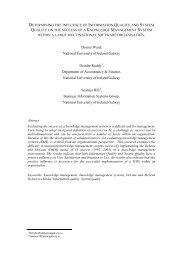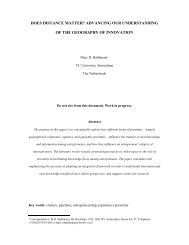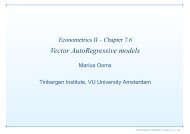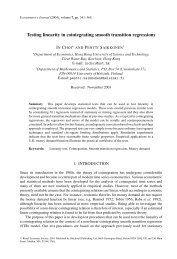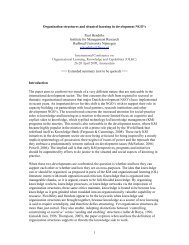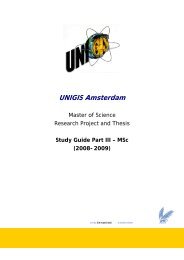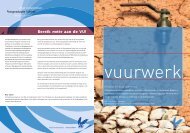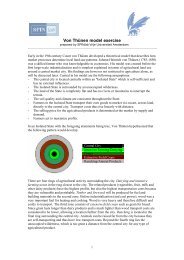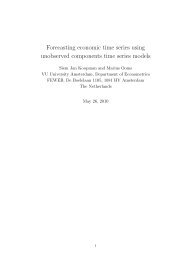to the I(1) - Feweb
to the I(1) - Feweb
to the I(1) - Feweb
You also want an ePaper? Increase the reach of your titles
YUMPU automatically turns print PDFs into web optimized ePapers that Google loves.
Introduction<br />
Econometrics II – Chapter 7.5<br />
Regression model with lags<br />
One-equation cointegration<br />
Marius Ooms<br />
Tinbergen Institute Amsterdam<br />
Section 7.5 considers bivariate dynamic processes with a<br />
dynamic regression interpretation.<br />
One variable is considered dependent and, in addition <strong>to</strong><br />
lagged values of <strong>the</strong> dependent variable, current and<br />
lagged values of <strong>the</strong> o<strong>the</strong>r explana<strong>to</strong>ry variable, that is<br />
considered predetermined in <strong>the</strong> equation.<br />
Such a relation is called an au<strong>to</strong>regressive distributed<br />
lag (A(R)DL) relation. MA error terms can sometimes be<br />
allowed for. We first assume joint stationarity of y and x for<br />
estimation purposes: ”I(0)” world.<br />
Chapter 7.5 – p. 1/30<br />
Chapter 7.5 – p. 3/30<br />
Contents<br />
Introduction<br />
Au<strong>to</strong>regressive Distributed Lag Model in I(0) world<br />
Equilibrium Correction Model (ECM) in I(0) world<br />
long run equilibrium<br />
equilibrium correction<br />
o<strong>the</strong>r economic dynamic regression models<br />
(non)exogeneity, consequences<br />
Cointegration: ADL/ECM in I(1) world<br />
spurious regression<br />
cointegration<br />
Structural interpretation<br />
Lagged dependent terms in A(R)DL models motivated by<br />
economic <strong>the</strong>ory (partial adjustment, adaptive<br />
expectations, equilibrium correction), ra<strong>the</strong>r than just<br />
modelling serial correlation: <strong>the</strong> ADL model is a structural<br />
equation with interpretable parameters.<br />
Interpretation and estimation parameters depends on<br />
exogeneity assumptions on x.<br />
Example §7.5: yt: US inflation. xt: US tbill rate. See below.<br />
Chapter 7.5 – p. 2/30<br />
Chapter 7.5 – p. 4/30
AR distributed lag model (ADL(p,r))<br />
We study <strong>the</strong> ADL(1, 1) model<br />
yt = α + φyt−1 + β0xt + β1xt−1 + εt,<br />
where |φ| < 1: stability condition in this context. The error<br />
term, εt, is White Noise. xt is considered predetermined in<br />
<strong>the</strong> equation or, in more general terms: (weakly)<br />
exogenous with respect <strong>to</strong> <strong>the</strong> estimation of <strong>the</strong><br />
parameters α, φ, β0 and β1. This requires that xt is<br />
uncorrelated with εt,εt+1,....<br />
The model can be re-formulated in DL(∞) form <strong>to</strong> show<br />
<strong>the</strong> response of yt,yt+1,... <strong>to</strong> one-time changes in xt:<br />
dynamic impact (”impulse response”)<br />
ARDL example US inflation, Interest rates<br />
US Core inflation (SA), 3-month T-bill, 59.1-99.12<br />
24<br />
20<br />
16<br />
12<br />
8<br />
4<br />
0<br />
-4<br />
-8<br />
60 65 70 75 80 85 90 95<br />
USCOREINFSA TBAA3M<br />
Chapter 7.5 – p. 5/30<br />
Chapter 7.5 – p. 7/30<br />
Dynamic impact, ARDL(0,∞) form of ARDL(1,1)<br />
(1 − φL)yt = α + (β0 + β1L)xt + εt,<br />
φ(L)yt = α + β(L)xt + εt,<br />
yt = αφ −1 (1) + φ −1 (L)β(L)xt + φ −1 (L)εt.<br />
∂yt<br />
∂xt<br />
∂yt+1<br />
∂xt<br />
∂yt+j<br />
= β0,<br />
= β1 + φβ0,<br />
.<br />
∂xt<br />
= φ j−1 (β1 + φβ0), for j > 0.<br />
Note that <strong>the</strong> influence on yt+j disappears as j → ∞.<br />
ARDL(6,4) estimation example ’reduced form’<br />
Modelling UScoreinfSA by OLS<br />
The estimation sample is: 62 (1) <strong>to</strong> 99 (12)<br />
Coefficient Std.Error t-value t-prob<br />
UScoreinfSA_1 0.233366 0.04750 4.91 0.000<br />
...<br />
UScoreinfSA_6 0.102451 0.04612 2.22 0.027<br />
Constant 0.239006 0.3136 0.762 0.446<br />
tbaa3m 0.867091 0.2383 3.64 0.000<br />
tbaa3m_1 -0.646922 0.3798 -1.70 0.089<br />
...<br />
tbaa3m_4 -0.340460 0.2405 -1.42 0.158<br />
sigma 2.54947 RSS 2885.89892<br />
Rˆ2 0.542968 F(11,444) = 47.95 [0.000]**<br />
log-likelihood -1067.72 DW 2.04<br />
no. of observations 456 no. of parameters 12<br />
mean(UScoreinfSA) 4.54782 var(UScoreinfSA) 13.8475<br />
Chapter 7.5 – p. 6/30<br />
Chapter 7.5 – p. 8/30
ARDL dynamic impact of x, example<br />
Dynamic impact interest rate on inflation (scaled, sum=1)<br />
2<br />
1<br />
0<br />
−1<br />
2.5<br />
2.0<br />
1.5<br />
1.0<br />
tbaa3m<br />
Impact tbaa3m (normalized) on UScoreinfSA<br />
0 5 10 15 20 25 30<br />
tbaa3m(cum)<br />
Cumulative impact tbaa3m (normalized) on UScoreinfSA<br />
0 5 10 15 20 25 30 35 40<br />
Long-run elasticity<br />
When y,x is in logs, <strong>the</strong>n<br />
λ = β(1)<br />
φ(1) =<br />
∞<br />
j=0<br />
∂yt+j<br />
∂xt<br />
can be interpreted as a “long-run elasticity”.<br />
Chapter 7.5 – p. 9/30<br />
Chapter 7.5 – p. 11/30<br />
Long run “equilibrium relationships” from ADL eq.<br />
Thought experiment: keep xt = ¯x constant, put all εt = 0<br />
and compute <strong>the</strong> value for yt after convergence (assuming<br />
this is <strong>the</strong> only dynamic relationship between xt and yt),<br />
that is ¯y.<br />
The “equilibrium” is<br />
or, in general,<br />
¯y = δ + φ¯y + β0¯x + β1¯x,<br />
¯y = α β(1)<br />
+<br />
φ(1) φ(1) ¯x.<br />
Long run relation Inflation Interest Rate?<br />
US interest rate vs. inflation 62-99(Fisher equation)<br />
USCOREINFSA<br />
24<br />
20<br />
16<br />
12<br />
8<br />
4<br />
0<br />
-4<br />
-8<br />
2 4 6 8 10 12 14 16 18<br />
TBAA3M<br />
Chapter 7.5 – p. 10/30<br />
Chapter 7.5 – p. 12/30
Long run equation implied by ARDL<br />
By simple calculations one can derive a long run relation<br />
between x and y from <strong>the</strong> ARDL and test its significance:<br />
Solved static long run equation for UScoreinfSA<br />
Coefficient Std.Error t-value t-prob<br />
Constant 1.07147 1.445 0.742 0.459<br />
tbaa3m 0.558555 0.2175 2.57 0.011<br />
ECM = UScoreinfSA - 1.07147 - 0.558555*tbaa3m; (Equilibrium correction<br />
mechanism)<br />
Inverse Roots of UScoreinfSA lag polynomial (is AR part stable?):<br />
real imag modulus<br />
0.92014 0.00000 0.92014<br />
0.32600 0.61182 0.69326<br />
...<br />
-0.34068 -0.48614 0.59363<br />
How <strong>to</strong> derive <strong>the</strong> Equilibrium correction term? See next!<br />
Example: ECM unrestricted: eq. (2)<br />
Exercise (1): Compute long run semi- elasticity λ from OLS<br />
output:<br />
Dependent Variable: DUSCOREINFSA<br />
Method: Least Squares<br />
Sample: 1962:01 1999:12<br />
Included observations: 456<br />
Variable Coefficient Std. Error t-Statistic Prob.<br />
C 0.239006 0.313641 0.762036 0.4464<br />
DUSCOREINFSA(-1) -0.543571 0.063107 -8.613422 0.0000<br />
DUSCOREINFSA(-2) -0.319701 0.064293 -4.972542 0.0000<br />
DUSCOREINFSA(-3) -0.297513 0.061498 -4.837784 0.0000<br />
DUSCOREINFSA(-4) -0.206045 0.058424 -3.526735 0.0005<br />
DUSCOREINFSA(-5) -0.102451 0.046116 -2.221614 0.0268<br />
DTBAA3M 0.867091 0.238304 3.638592 0.0003<br />
DTBAA3M(-1) 0.095577 0.247830 0.385655 0.6999<br />
DTBAA3M(-2) 1.090760 0.243602 4.477637 0.0000<br />
DTBAA3M(-3) 0.340460 0.240463 1.415852 0.1575<br />
USCOREINFSA(-1) -0.223063 0.053931 -4.136090 0.0000<br />
TBAA3M(-1) 0.124593 0.063355 1.966567 0.0499<br />
R-squared 0.393532 Mean dependent var 0.003614<br />
Adjusted R-squared 0.378507 S.D. dependent var 3.233931<br />
S.E. of regression 2.549465 Akaike info criterion 4.735608<br />
Sum squared resid 2885.899 Schwarz criterion 4.844094<br />
Log likelihood -1067.719 F-statistic 26.19159<br />
Durbin-Watson stat 2.040891 Prob(F-statistic) 0.000000<br />
Chapter 7.5 – p. 13/30<br />
Chapter 7.5 – p. 15/30<br />
Equilibrium (Error) Correction Model (E(q)CM)<br />
The ECM explains <strong>the</strong> change in y using one lagged level<br />
of y and x and one or more lagged differences of y and<br />
x. The ECM representation of <strong>the</strong> ADL model is easier <strong>to</strong><br />
interpret and often easier <strong>to</strong> estimate. In <strong>the</strong> univariate<br />
case, β(L) = 0, it reduces <strong>to</strong> an (A)D-F regression.<br />
yt = α + φyt−1 + β0xt + β1xt−1 + εt, (1)<br />
∆yt = α − (1 − φ)yt−1 + β0∆xt + (β0 + β1)xt−1 + εt, (2)<br />
= β0∆xt − (1 − φ)[yt−1 − δ − λxt−1] + εt, (3)<br />
δ =<br />
α<br />
(1 − φ) , λ = (β0 + β1)<br />
(1 − φ) .<br />
δ and λ are ‘<strong>the</strong> ‘equilibrium” coefficients.<br />
Decomposition ECM model<br />
The ECM specification (3) decomposes a change in y in<strong>to</strong><br />
two components,<br />
1. from change in x: ∆xt: direct short run effect<br />
2. from lagged equilibrium error: zt−1 where<br />
zt = yt − δ − λxt<br />
When yt is higher than equilibrium value (positive z), y will<br />
adjust downwards in order <strong>to</strong> get back <strong>to</strong> equilibrium:<br />
Equilibrium (error) correction.<br />
Remember: §7.5 assumes <strong>the</strong>re is no feedback (Granger<br />
non-causality) from y <strong>to</strong> x!<br />
Chapter 7.5 – p. 14/30<br />
Chapter 7.5 – p. 16/30
Example: ECM term time series plot<br />
20<br />
15<br />
10<br />
5<br />
0<br />
-5<br />
-10<br />
-15<br />
ECM term = UScoreinfSA - 1.07 - 0.56*tbaa3m<br />
1965 1970 1975 1980 1985 1990 1995<br />
ECMTERM<br />
Chapter 7.5 – p. 17/30<br />
Partial Scatterplot ECM effect, (c.f. §3.2.5 Case 3)<br />
DUSCOREINFSAPARTIAL vs. ECMTERMLAGGEDPARTIAL<br />
DUSCOREINFSAPARTIAL<br />
15<br />
10<br />
5<br />
0<br />
-5<br />
-10<br />
-6 -4 -2 0 2 4 6 8 10<br />
ECMTERMLAGGEDPARTIAL<br />
Chapter 7.5 – p. 19/30<br />
Example: ECM estimation eq. (3) with known λ<br />
Exercise (2): Compute ”adjustment coefficient” (− φ(1)<br />
from OLS output.<br />
Dependent Variable: DUSCOREINFSA<br />
Method: Least Squares<br />
Sample(adjusted): 1962:02 1999:12<br />
Included observations: 455 after adjusting endpoints<br />
Variable Coefficient Std. Error t-Statistic Prob.<br />
C 0.001846 0.119532 0.015444 0.9877<br />
DUSCOREINFSA(-1) -0.543513 0.061869 -8.784847 0.0000<br />
DUSCOREINFSA(-2) -0.319760 0.063442 -5.040161 0.0000<br />
DUSCOREINFSA(-3) -0.298213 0.060994 -4.889204 0.0000<br />
DUSCOREINFSA(-4) -0.205761 0.058014 -3.546746 0.0004<br />
DUSCOREINFSA(-5) -0.104175 0.046282 -2.250878 0.0249<br />
DTBAA3M 0.868916 0.236007 3.681734 0.0003<br />
DTBAA3M(-1) 0.093375 0.245796 0.379888 0.7042<br />
DTBAA3M(-2) 1.093816 0.242643 4.507912 0.0000<br />
DTBAA3M(-3) 0.339643 0.239119 1.420392 0.1562<br />
ECMTERM(-1) -0.223273 0.052104 -4.285112 0.0000<br />
R-squared 0.393677 Mean dependent var 0.003294<br />
Adjusted R-squared 0.380021 S.D. dependent var 3.237484<br />
S.E. of regression 2.549155 Akaike info criterion 4.733280<br />
Sum squared resid 2885.197 Schwarz criterion 4.832891<br />
Log likelihood -1065.821 F-statistic 28.82824<br />
Durbin-Watson stat 2.039039 Prob(F-statistic) 0.000000<br />
Direct estimation ECM λ and s.e. in Eviews<br />
Chapter 7.5 – p. 18/30<br />
(Advanced) Exercise (3): Explain why <strong>the</strong> coefficient of rt<br />
is estimated using 2SLS and why it is a consistent estimate<br />
of λ. Hint: Apply <strong>the</strong> decomposition α0 + α1L = α(1) − α1∆<br />
<strong>to</strong> φ(L) and β(L).<br />
Dependent Variable: USCOREINFSA<br />
Method: Two-Stage Least Squares<br />
Date: 02/10/03 Time: 10:51<br />
Sample: 1962:01 1999:12<br />
Included observations: 456<br />
Instrument list: C TBAA3M DTBAA3M(0 TO -3) DUSCOREINFSA(-1<br />
TO -5) USCOREINFSA(-1)<br />
Variable Coefficient Std. Error t-Statistic Prob.<br />
C 1.071473 1.444886 0.741562 0.4587<br />
TBAA3M 0.558555 0.217458 2.568569 0.0105<br />
DUSCOREINFSA -3.483041 1.083884 -3.213482 0.0014<br />
DUSCOREINFSA(-1) -2.436850 0.808796 -3.012937 0.0027<br />
DUSCOREINFSA(-2) -1.433233 0.555871 -2.578358 0.0102<br />
DUSCOREINFSA(-3) -1.333765 0.507371 -2.628777 0.0089<br />
DUSCOREINFSA(-4) -0.923709 0.398263 -2.319342 0.0208<br />
DUSCOREINFSA(-5) -0.459293 0.257246 -1.785425 0.0749<br />
DTBAA3M 3.328652 1.381126 2.410101 0.0164<br />
DTBAA3M(-1) 0.428475 1.124256 0.381118 0.7033<br />
DTBAA3M(-2) 4.889923 1.678523 2.913231 0.0038<br />
DTBAA3M(-3) 1.526295 1.140696 1.338038 0.1816<br />
R-squared -8.185267 Mean dependent var 4.547815<br />
Adjusted R-squared -8.412830 S.D. dependent var 3.725304<br />
S.E. of regression 11.42936 Sum squared resid 57999.81<br />
F-statistic 2.386014 Durbin-Watson stat 2.040891<br />
Prob(F-statistic) 0.007054<br />
Chapter 7.5 – p. 20/30
Partial Adjustment interpretation ADL(1,0)<br />
NB: in following two examples: λ is an adjustment<br />
parameter, not equilibrium parameter. δ is equilibrium<br />
parameter, not a constant term.<br />
Partial adjustment<br />
The economic structural model:<br />
with ADL model:<br />
yt = yt−1 + λ(y ∗ t − yt−1) + εt<br />
y ∗ t = γ + δxt<br />
yt = λγ + (1 − λ)yt−1 + λδxt + εt : ADL(1, 0).<br />
Exercise (4): Derive this ADL model.<br />
(Weak) exogeneity<br />
Chapter 7.5 – p. 21/30<br />
In <strong>the</strong> context of ECM models one often extends <strong>the</strong> old<br />
concept of predeterminedness (“independence” of<br />
regressor variable and present and future structural<br />
equation errors) <strong>to</strong> <strong>the</strong> concept of weak exogeneity. (Short:<br />
exogeneity in §4.1.3: plim 1<br />
n X′ ε) = 0).<br />
A variable xt is said <strong>to</strong> be weakly exogenous for estimating<br />
a parameter of interest λ, if inference on λ conditional on xt<br />
involves no loss of information. In practice joint modelling<br />
of yt and xt does not improve inference on λ if xt is weakly<br />
exogenous.<br />
Strict exogeneity: “Independence” of regressors and<br />
structural equation errors at all leads and lags, does not<br />
apply <strong>to</strong> ECM.<br />
Chapter 7.5 – p. 23/30<br />
Adaptive expectations ARDL(1,0)-MA(1)<br />
Adaptive Expectations<br />
The economic structural model, where <strong>the</strong> true explana<strong>to</strong>ry<br />
variable (i.c. expected x) x ∗ t+1 is unobserved.<br />
yt = γ + δx ∗ t+1 + εt<br />
x ∗ t+1 = x ∗ t + λ(xt − x ∗ t)<br />
The corresponding ARDL(1,0) form has MA(1) errors<br />
yt = λγ + (1 − λ)yt−1 + λδxt + εt − (1 − λ)εt−1,<br />
which can also be written in ARDL(0,∞) form:<br />
yt = γ + (1 − (1 − λ)L)) −1 λδxt + εt.<br />
Exercise (5): derive this ARDL(0,∞) form.<br />
Strong exogeneity, Granger non-causality<br />
The ADL model can be used as part of a forecasting<br />
procedure for yt. If we want efficient inference on future yt<br />
without making a joint dynamic model for yt and xt we<br />
need a strong exogeneity assumption.<br />
Strong Exogeneity of xt for (forecasting) equation yt<br />
combines two requirements:<br />
1. (Weak) exogeneity of xt for estimating all <strong>the</strong><br />
parameters of <strong>the</strong> equation for yt<br />
2. Granger non-causality of yt for xt, §7.6.2<br />
In linear forecasting of xt using lags of xt, additional<br />
lags of yt do not decrease forecast MSE: Partial<br />
correlations of xt with yt−1,yt−2,... are zero.<br />
Regression F -test for Granger-noncausality in<br />
auxiliary equation for xt.<br />
Chapter 7.5 – p. 22/30<br />
Chapter 7.5 – p. 24/30
Extending ARDL from <strong>the</strong> I(0) <strong>to</strong> <strong>the</strong> I(1) world<br />
The ARDL model can also be used for nonstationary<br />
series, but <strong>the</strong>n one has <strong>to</strong> be careful with statistical<br />
inference. Standard distribution <strong>the</strong>ory does not apply. In<br />
<strong>the</strong> I(1) world <strong>the</strong> notion of long run equilibrium<br />
corresponds <strong>to</strong> cointegration and <strong>the</strong> existence of a<br />
common trend.<br />
Cointegration does not require strong exogeneity of x for<br />
<strong>the</strong> estimation of <strong>the</strong> parameters in <strong>the</strong> ARDL equation(s).<br />
It does require I(1)-ness of both x and y.<br />
Spurious regression, non-cointegration<br />
Regress I(1) process yt on independent I(1) process xt.<br />
This means <strong>the</strong> residual process is also I(1)!<br />
OLS based inference (§2.3): Overrejection of H0 of<br />
independence because of extremely strong positive serial<br />
correlation in <strong>the</strong> error term.<br />
GMM based inference (§5.5.3) (au<strong>to</strong>matic “Newey-West<br />
correction” for serial correlation in error term) does not<br />
work for I(1) ei<strong>the</strong>r. The moments of GMM do not exist!<br />
Correction for determistic trend does not work ei<strong>the</strong>r. The<br />
’omitted trend variable’ is not observed!<br />
Chapter 7.5 – p. 25/30<br />
Chapter 7.5 – p. 27/30<br />
Cointegration and Spurious Regression<br />
Definition cointegration: yt, xt ∼ CI(1, 1):<br />
yt ∼ I(1), xt ∼ I(1), linear combination (yt − λxt) ∼ I(0).<br />
yt − λxt integrated of order 1-1=0. Cointegration concerns<br />
only <strong>the</strong> s<strong>to</strong>chastic part of series, i.e. not <strong>the</strong> deterministic<br />
part.<br />
Spurious regression:<br />
yt ∼ I(1), xt ∼ I(1), yt and xt independent, regress yt on<br />
constant and xt (so that residuals of spurious regression<br />
are also I(1)).<br />
Spurious regression problem:<br />
Apply assumption of I(0) (or even WN) <strong>to</strong> I(1) variables in<br />
assessing statistical significance of correlations and<br />
regression coefficients. Result: incorrect rejection of H0 :<br />
“no linear relationship”.<br />
Cointegration in <strong>the</strong> ADL model<br />
Consider <strong>the</strong> ARDL model with xt ∼ I(1):<br />
yt = α + φyt−1 + β0xt + β1xt−1 + εt<br />
xt = xt−1 + ηt<br />
Chapter 7.5 – p. 26/30<br />
with εt, ηt independent WN, |φ| < 1, β0 + β1 = 0, so<br />
xt ∼ I(1) and yt = (1 − φL) −1 [α + β0xt + β1xt−1 + εt] ∼ I(1).<br />
There is no long run equilibrium value for x.<br />
∆yt is a stationary, invertible ARMA(1,1) process and<br />
<strong>the</strong>refore I(0). This means yt is I(1).<br />
yt fluctuates around [α0 + (β0 + β1)xt]/(1 − φ).<br />
One can show that yt and xt are cointegrated with one<br />
common trend: (1 − L) −1 ηt.<br />
Chapter 7.5 – p. 28/30
ARDL in ECM form in I(1) world<br />
The error/equilibrium correction form is:<br />
∆yt = β0∆xt − (1 − φ)zt−1 + εt,<br />
where deviation from equilibrium zt is defined as<br />
zt = yt −<br />
α<br />
(1 − φ) − (β0 + β1)<br />
(1 − φ) xt.<br />
Advanced Exercise (6): Prove zt is I(0), <strong>the</strong>refore xt and yt<br />
are CI(1,1). Hint: Apply <strong>the</strong> ”unit root” decompositions<br />
α0 + α1L = α(1) − α1∆ and/or α0 + α1L = α0∆ + α(1)L <strong>to</strong><br />
φ(L) and/or β(L). Note connection with Advanced Exercise<br />
(3)<br />
Chapter 7.5 – p. 29/30<br />
Warning: Coefficient tests in ECM in I(1) world<br />
OLS/GMM inference on coefficient tests in ECM with<br />
possible I(1) regressors is not standard, not even without<br />
serial correlation in <strong>the</strong> residuals. Some t− tests are<br />
asymp<strong>to</strong>tically normal. Some are not!<br />
Standard I(0) inference: t-tests with standard normal tables.<br />
Standard t-test examples, test for:<br />
- φ = 0 (coeff of yt−1 in (2)): test immediate full adjustment of y <strong>to</strong><br />
disequilibrium.<br />
- β0 = 0 (coeff of ∆xt in (2)): zero direct impact x on y.<br />
Nonstandard t-test examples, test for<br />
- (1 − φ) = 0 (coeff of yt−1 if no ECM): cf. Augmented DF,<br />
- β0 + β1 = 0 (coeff for xt−1 in (2) if no ECM): a test for<br />
non-cointegration. Warning: Coefficient tests involving I(1)<br />
regressors under H0 can have nonstandard limiting distributions.<br />
Chapter 7.5 – p. 30/30





